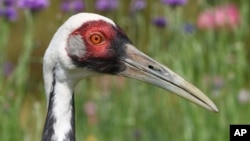Unfortunately, an epic love story between different species has come to a close.
Internet sensation and beloved white-naped crane, Walnut, has passed away at the age of 42. She is survived by her eight offspring, the dedicated team at the Smithsonian’s National Zoo and Conservation Biology Institute, and her longtime human caretaker Chris Crowe, who she considered her mate for two decades.
According to a statement from the National Zoo, Crowe expressed his gratitude for the bond he shared with Walnut, noting her vibrant personality as a unique aspect of her character.
The story of Walnut (and Chris) has become a sensation on the internet and even sparked a love song. It originated in 2004 when the bird first arrived on the campus of the institute in Front Royal, Virginia.
The chick of two wild cranes who had been brought to the U.S. illegally and were later rescued by the International Crane Foundation, Walnut was hand-raised by people and bonded with her human caretakers. That preference continued when she came to the institute; she showed no interest in breeding and even attacked male crane suitors.
The International Union for Conservation of Nature has classified white-naped cranes as vulnerable. Currently, there are less than 5,300 of these cranes left in their natural habitats in Mongolia, Siberia, Korea, Japan, and China due to factors such as habitat loss, pollution, nest predation, and poaching. As Walnut’s parents were both caught from the wild, her genetic makeup was not present in any U.S. zoos. Therefore, it was seen as crucial to encourage Walnut to reproduce.
Crowe joined the group and, as stated by the zoo, impressed them by imitating the behaviors of the male white-naped cranes during their breeding season.
The footage depicts Crowe providing Walnut with nourishment such as grass and leaves to use for constructing her nest. As Crowe waves his arms in front of her, the magnificent bird flaps her wings enthusiastically and performs a half-circle dance with her head moving up and down. After earning her confidence, Crowe successfully fertilized her using semen from a male crane.
The unconventional setup was a huge success, resulting in Walnut having a total of eight offspring. Other white-napped cranes took care of the fertilized eggs as if they were their own. Out of the eight white-napped cranes currently residing at the institute, two are descendants of Walnut: one is her direct offspring and the other is her grandchild.
The bond between Walnut and her caretakers appears to have positively impacted her health. At 42 years old, she exceeded the average life expectancy of 15 years for white-naped cranes in captivity.
In 1981, during the summer season, Walnut was born in Wisconsin. She was given her name in honor of a well-known walnut pie dessert from a restaurant in Wisconsin.
On January 2, caretakers observed that Walnut had stopped consuming food and liquids. Even her preferred snacks of frozen-thawed mice, peanuts, and mealworms did not entice her appetite. Veterinary professionals provided fluids, antibiotics, and collected blood samples for examination. However, her condition worsened and she was admitted to the hospital. She passed away peacefully with the support of the animal care staff, and an autopsy determined that she had succumbed to renal failure.
According to Crowe, she was consistently self-assured in her self-expression, a passionate and skilled dancer, and resilient when faced with difficulties in life. The remarkable tale of Walnut has shed light on the struggles of her endangered species. I hope that those who were moved by her story recognize the crucial role we play in preserving wetland habitats for the survival of her species.
Source: voanews.com




